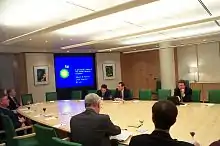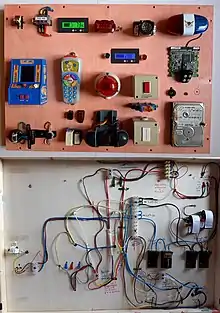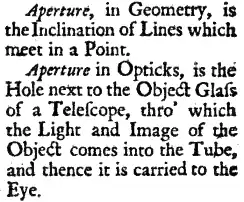Multimedia
Multimedia is a form of communication that combines different content forms such as text, audio, images, animations, or video into a single presentation, in contrast to traditional mass media, such as printed material or audio recordings. Popular examples of multimedia include video podcasts, audio slideshows, animated shows, and movies.
|
| |||||||||||||
Multimedia can be recorded for playback on computers, laptops, smartphones, and other electronic devices, either on demand or in real time (streaming). In the early years of multimedia, the term "rich media" was synonymous with interactive multimedia. Over time, hypermedia extensions brought multimedia to the World Wide Web.
Terminology
The term multimedia was coined by singer and artist Bob Goldstein (later 'Bobb Goldsteinn') to promote the July 1966 opening of his "LightWorks at L'Oursin" show at Southampton, Long Island.[1] Goldstein was perhaps aware of an American artist named Dick Higgins, who had two years previously discussed a new approach to art-making he called "intermedia".[2]
On August 10, 1966, Richard Albarino of Variety borrowed the terminology, reporting: "Brainchild of songscribe-comic Bob ('Washington Square') Goldstein, the 'Lightworks' is the latest multi-media music-cum-visuals to debut as discothèque fare."[3] Two years later, in 1968, the term "multimedia" was re-appropriated to describe the work of a political consultant, David Sawyer, the husband of Iris Sawyer—one of Goldstein's producers at L'Oursin.

In the intervening forty years, the word has taken on different meanings. In the late 1970s, the term referred to presentations consisting of multi-projector slide shows timed to an audio track. However, by the 1990s 'multimedia' took on its current meaning.
In the 1993 first edition of Multimedia: Making It Work, Tay Vaughan declared "Multimedia is any combination of text, graphic art, sound, animation, and video that is delivered by computer. When you allow the user – the viewer of the project – to control what and when these elements are delivered, it is interactive multimedia. When you provide a structure of linked elements through which the user can navigate, interactive multimedia becomes hypermedia."[4]
The German language society Gesellschaft für deutsche Sprache recognized the word's significance and ubiquitousness in the 1990s by awarding it the title of German 'Word of the Year' in 1995.[5] The institute summed up its rationale by stating "[Multimedia] has become a central word in the wonderful new media world".[6]
In common usage, multimedia refers to an electronically delivered combination of media including video, still images, audio, and text in such a way that can be accessed interactively. Much of the content on the web today falls within this definition as understood by millions. Some computers which were marketed in the 1990s were called "multimedia" computers because they incorporated a CD-ROM drive, which allowed for the delivery of several hundred megabytes of video, picture, and audio data. That era saw also a boost in the production of educational multimedia CD-ROMs. A standard CD-ROM can hold on average 700 megabytes of data, while the maximum size a 3.5 inch floppy disk can hold is 2.8 megabytes, with an average of 1.44 megabytes. [7]
The term "video", if not used exclusively to describe motion photography, is ambiguous in multimedia terminology. Video is often used to describe the file format, delivery format, or presentation format instead of "footage" which is used to distinguish motion photography from "animation" of rendered motion imagery. Multiple forms of information content are often not considered modern forms of presentation such as audio or video. Likewise, single forms of information content with single methods of information processing (e.g. non-interactive audio) are often called multimedia, perhaps to distinguish static media from active media. In the fine arts, for example, Leda Luss Luyken's ModulArt brings two key elements of musical composition and film into the world of painting: variation of a theme and movement of and within a picture, making ModulArt an interactive multimedia form of art. Performing arts may also be considered multimedia considering that performers and props are multiple forms of both content and media.
In modern times, a multimedia device can be referred to an electronic device, such as a smartphone, a videogame system, or a computer, for example. All of these devices have one main, but also have other functions beyond their intended purpose, such as reading, writing, recording video, streaming listening to music, and playing video games. This has lend them to be called "multimedia devices". While previous media was always local, many are now handled through web based solutions, particularly streaming.
Major characteristics
Multimedia presentations may be viewed by person on stage, projected, transmitted, or played locally with a media player. A broadcast may be a live or recorded multimedia presentation. Broadcasts and recordings can be either analog or digital electronic media technology. Digital online multimedia may be downloaded or streamed. Streaming multimedia may be live or on-demand.
Multimedia games and simulations may be used in a physical environment with special effects, with multiple users in an online network, or locally with an offline computer, game system, or simulator.
The various formats of technological or digital multimedia may be intended to enhance the users' experience, for example to make it easier and faster to convey information. Or in entertainment or art, to transcend everyday experience.

Enhanced levels of interactivity are made possible by combining multiple forms of media content. Online multimedia is increasingly becoming object-oriented and data-driven, enabling applications with collaborative end-user innovation and personalization on multiple forms of content over time. Examples of these range from multiple forms of content on Web sites like photo galleries with both images (pictures) and title (text) user-updated, to simulations whose co-efficients, events, illustrations, animations or videos are modifiable, allowing the multimedia "experience" to be altered without reprogramming. In addition to seeing and hearing, haptic technology enables virtual objects to be felt. Emerging technology involving illusions of taste and smell may also enhance the multimedia experience.
Categorization
Multimedia may be broadly divided into linear and non-linear categories:
- Linear active content progresses often without any navigational control for the viewers such as a cinema presentation;
- Non-linear uses interactivity to control progress as with a video game or self-paced computer-based training. Hypermedia is an example of non-linear content.
Multimedia presentations can be live or recorded:
- A recorded presentation may allow interactivity via a navigation system;
- A live multimedia presentation may allow interactivity via an interaction with the presenter or performer.
Usage/application

Multimedia finds its application in various areas including, but not limited to, advertisements, art, education, entertainment, engineering, medicine, mathematics, business, scientific research and spatial temporal applications. Several examples are as follows:
Creative industries
Creative industries use multimedia for a variety of purposes ranging from fine arts, to entertainment, to commercial art, to journalism, to media and software services provided for any of the industries listed below. An individual multimedia designer may cover the spectrum throughout their career. Request for their skills range from technical, to analytical, to creative.
Commercial uses
Much of the electronic old and new media used by commercial artists and graphic designers is multimedia. Exciting presentations are used to grab and keep attention in advertising. Business to business, and interoffice communications are often developed by creative services firms for advanced multimedia presentations beyond simple slide shows to sell ideas or liven up training. Commercial multimedia developers may be hired to design for governmental services and nonprofit services applications as well.
Entertainment and fine arts
Multimedia is heavily used in the entertainment industry, especially to develop special effects in movies and animations (VFX, 3D animation, etc.). Multimedia games are a popular pastime and are software programs available either as CD-ROMs or online. Video games class as multimedia, as such games meld animation, audio, and, most importantly, interactivity, to allow the player an immersive experience. While video games can vary in terms of animation style or audio type or even lack thereof, the element of interactivity makes them a striking example of interactive multimedia. Interactive multimedia defines multimedia applications that allow users to actively participate instead of just sitting by as passive recipients of information. In the arts there are multimedia artists, whose minds are able to blend techniques using different media that in some way incorporates interaction with the viewer. Another approach entails the creation of multimedia that can be displayed in a traditional fine arts arena, such as an art gallery. Although multimedia display material may be volatile, the survivability of the content is as strong as any traditional media. Digital recording material may be just as durable and infinitely reproducible with perfect copies every time.
Education
In education, multimedia is used to produce computer-based training courses (popularly called CBTs) and reference books like encyclopedia and almanacs. A CBT lets the user go through a series of presentations, text about a particular topic, and associated illustrations in various information formats.
Learning theory in the past decade has expanded dramatically because of the introduction of multimedia. Several lines of research have evolved, e.g. cognitive load and multimedia learning.
From multimedia learning (MML) theory, David Roberts has developed a large group lecture practice using PowerPoint and based on the use of full-slide images in conjunction with a reduction of visible text (all text can be placed in the notes view’ section of PowerPoint).[8] The method has been applied and evaluated in 9 disciplines. In each experiment, students’ engagement and active learning have been approximately 66% greater, than with the same material being delivered using bullet points, text, and speech, corroborating a range of theories presented by multimedia learning scholars like Sweller and Mayer.[9] The idea of media convergence is also becoming a major factor in education, particularly higher education. Defined as separate technologies such as voice (and telephony features), data (and productivity applications), and video that now share resources and interact with each other, media convergence is rapidly changing the curriculum in universities all over the world. Higher education has been implementing the use of social media applications such as Twitter, YouTube, Facebook, etc. to increase student collaboration and develop new processes in how information can be conveyed to students.[10]
Educational technology

Multimedia provides students with an alternate means of acquiring knowledge designed to enhance teaching and learning through various mediums and platforms.[11] In the 1960s, technology began to expand into the classrooms through devices such as screens and telewriters.[12] This technology allows students to learn at their own pace and gives teachers the ability to observe the individual needs of each student. The capacity for multimedia to be used in multi-disciplinary settings is structured around the idea of creating a hands-on learning environment through the use of technology. Lessons can be tailored to the subject matter as well as be personalized to the students' varying levels of knowledge on the topic. Learning content can be managed through activities that utilize and take advantage of multimedia platforms. This kind of usage of modern multimedia encourages interactive communication between students and teachers and opens feedback channels, introducing an active learning process especially with the prevalence of new media and social media.[13] Technology has impacted multimedia as it is largely associated with the use of computers or other electronic devices and digital media due to its capabilities concerning research, communication, problem-solving through simulations and feedback opportunities.[14] The innovation of technology in education through the use of multimedia allows for diversification among classrooms to enhance the overall learning experience for students.[15]
Social work
Multimedia is a robust education methodology within the social work context. The five different multimedia which supports the education process are narrative media, interactive media, communicative media, adaptive media, and productive media. Contrary to long-standing belief, multimedia technology in social work education existed before the prevalence of the internet. It takes the form of images, audio, and video into the curriculum.
First introduced to social work education by Seabury & Maple in 1993, multimedia technology is utilized to teach social work practice skills including interviewing, crisis intervention, and group work. In comparison with conventional teaching method, including face-to-face courses, multimedia education shortens transportation time, increases knowledge and confidence in a richer and more authentic context for learning, generates interaction between online users, and enhances understanding of conceptual materials for novice students.
In an attempt to examine the impact of multimedia technology on students’ study, A. Elizabeth Cauble & Linda P. Thurston conducted a research in which Building Family Foundations (BFF), an interactive multimedia training platform, was utilized to assess social work students’ reactions to multimedia technology on variables of knowledge, attitudes, and self-efficacy. The results states that respondents show a substantial increase in academic knowledge, confidence, and attitude. Multimedia also benefits students because it brings expert to students online, fits students’ schedule, allows students to choose courses that suit them.
Mayer's Cognitive Theory of Multimedia Learning suggests, "people learn more from words and pictures than from words alone." According to Mayer and other scholars, multimedia technology stimulates people's brains by implementing visual and auditory effects, and thereby assists online users to learn efficiently. Researchers suggest that when users establish dual channels while learning, they tend to understand and memorize better. Mixed literature of this theory are still present in the field of multimedia and social work.
Language communication
With the spread and development of the English language around the world, multimedia has become an important way of communicating between different people and cultures. Multimedia Technology creates a platform where language can be taught. The traditional form of teaching English as a Second Language (ESL) in classrooms have drastically changed with the prevalence of technology, making easier for students to obtain language learning skills. Multimedia motivates students to learn more languages through audio, visual and animation support. It also helps create English contexts since an important aspect of learning a language is developing their grammar, vocabulary and knowledge of pragmatics and genres. In addition, cultural connections in terms of forms, contexts, meanings and ideologies have to be constructed. By improving thought patterns, multimedia develops students’ communicative competence by improving their capacity to understand the language.[19] One of the studies, carried out by Izquierdo, Simard and Pulido, presented the correlation between "Multimedia Instruction (MI) and learners’ second language (L2)"[20] and its effects on learning behavior. Their findings based on Gardner’s theory of the "socio-educational model of learner motivation and attitudes", the study shows that there is easier access to language learning materials as well as increased motivation with MI along with the use of Computer-Assisted Language Learning.
Journalism
Newspaper companies all over are trying to embrace the new phenomenon by implementing its practices in their work. While some have been slow to come around, other major newspapers like The New York Times, USA Today and The Washington Post are setting the precedent for the positioning of the newspaper industry in a globalized world. To keep up with the changing world of multimedia, journalistic practices are adopting and utilizing different functions of multimedia through the inclusions of visuals such as varying audio, video, text, etc. in their writings.[21]
News reporting is not limited to traditional media outlets. Freelance journalists can make use of different new media to produce multimedia pieces for their news stories. It engages global audiences and tells stories with technology, which develops new communication techniques for both media producers and consumers. The Common Language Project, later renamed to The Seattle Globalist, is an example of this type of multimedia journalism production.
Multimedia reporters who are mobile (usually driving around a community with cameras, audio and video recorders, and laptop computers) are often referred to as mojos, from mobile journalist.
Engineering
Software engineers may use multimedia in computer simulations for anything from entertainment to training such as military or industrial training. Multimedia for software interfaces are often done as a collaboration between creative professionals and software engineers. Multimedia helps expand the teaching practices that can be found in engineering to allow for more innovated methods to not only educated future engineers, but to help evolve the scope of understanding of where multimedia can be used in specialized engineer careers like software engineers.[22]
Multimedia is also allowing major car manufactures, such as Ford, and General Motors, to expand the design, and safety standards of their cars. By using a game engine and VR glasses, these companies are able to test the safety features, and the design of the car, before a prototype is even made. Building a car virtually reduces the time it takes to produce new vehicles, cutting down on the time needed to test designs, and allowing the designers to make changes in real time. It also reduces expenses, since with a virtual car making real world prototypes is no longer needed.[23]
Mathematical and scientific research
In mathematical and scientific research, multimedia is mainly used for modeling and simulation. For example, a scientist can look at a molecular model of a particular substance and manipulate it to arrive at a new substance. Representative research can be found in journals such as the Journal of Multimedia.
Medicine
Multimedia is used heavily in modern medicine. Doctors can be trained using videos or virtual demonstrations. Medical students use online resources such as virtual labs and interactive diagrams further their knowledge of the human body and what can happen to it if someone's health is compromised. They can also simulate how the human body is affected by diseases. Multimedia in medicine could also be used to create new ways to prevent the further spread of diseases such as vaccines and cures and more. Especially by using what we already have to help advance further experimentation in order to access new information for the world of science and medicine.
Virtual reality
Virtual reality is a new platform for multimedia in which it merges all categories of multimedia into one virtual environment. It has gained much more attention over the years following technological advancements and is becoming much more commonly used nowadays for various uses like virtual showrooms and video games. Virtual reality was first introduced in 1957 by cinematographer Morton Heilig in the form of an arcade style booth called Sensorama. The first virtual reality headset was created by American computer scientist Ivan Sutherland and Bob Sproull, his student, in 1968. Virtual reality is used for educational and also recreational purposes like watching movies, interactive video games, simulations etc. Ford Motor Company uses this technology to show customers the interior and exterior of their cars via their Immersion Lab.[24] In Pima County, Arizona their police force is trained by using Virtual Reality to create scenarios for police to practice in.[25] Many video game platforms now support VR technology, including Sony's PlayStation, Nintendo's Switch, as well as the Oculus VR headsets that can be used for PC gaming.
Augmented reality
While virtual reality (VR) strives to be a totally immersive multimedia experience, completely replacing reality with a digital simulation, augmented reality (AR) limits itself to overlaying digital output or content onto the real world. AR can be defined as "an enhanced version of reality created by the use of technology to overlay digital information on an image of something being viewed through a device (such as a smartphone camera)".[26] AR systems can be used for tasks such as overlaying speed, altitude and heading information on an aircraft Heads-Up Display (HUD), or projecting images or animations into a real-life scene, such as in the game Pokémon Go.[27] Sony uses AR technology in their PlayStation 5 controllers with their haptic feedback[28] feature to give users a greater sense of immersion while playing video games. For example, while users are playing Call of Duty and want to shoot their gun at the enemy, the triggers on the controller will provide tension to the player that will make it feel like they are actually pulling the trigger on a gun. The game Astro's Playroom that comes with a PlayStation 5 console showcases the different ways a game can make players feel more immersed and the depth and potential that the haptic feedback feature has for the future of gaming.
Associations and conferences
In Europe, the reference organisation for the multimedia industry is the European Multimedia Associations Convention (EMMAC).
Scholarly conferences about multimedia include:
- ACM Multimedia
- IEEE International Conference on Multimedia & Expo (ICME)
MENOS
Multimedia Exchange Network Over Satellite (MENOS) is a communications protocol for exchanging multimedia content using communications satellites, most commonly used by professional broadcasters.[29][30][31] Using MENOS, content that used to be stored on tape can now be stored on hard disks and be used on-demand, thereby generating more revenues. Broadcasters can now offer their member stations E/T-1 type connectivity for intranet access/internet access thereby reducing significant costs.
The main achievements of the MENOS project are:
- Successful integration of MF-TDMA broadband Access Network and DVB-S2 SCPC Network integration into one platform;
- Optimum usage of satellite bandwidth usage;
- Flexible multimedia exchange and archiving functionality;
- The addition of several value added services such as VoIP and VPN;
- Central management of the system;
- Development of several terminal types to access the network. (Radio, TV and IP) [32]
See also
References
- Badii, Atta; Fuschi, David; Khan, Ali; Adetoye, Adedayo (2009-11-09). Accessibility-by-Design: A Framework for Delivery-Context-Aware Personalised Media Content Re-purposing. HCI and Usability for E-Inclusion. Lecture Notes in Computer Science. Springer, Berlin, Heidelberg. pp. 209–226. doi:10.1007/978-3-642-10308-7_14. ISBN 9783642103070.
- Matthew Zuras (June 3, 2010), Tech Art History, Part, Switched
- Richard Albarino, "Goldstein's LightWorks at Southhampton," Variety, August 10, 1966. Vol. 213, No. 12.
- Vaughan, Tay, 1993, Multimedia: Making It Work (first edition, ISBN 0-07-881869-9), Osborne/McGraw-Hill, Berkeley, pg. 3.
- Ein Jahr, ein (Un-)Wort! (in German) Spiegel Online
- Variety, January 1–7, 1996.
- https://www.sciencedirect.com/topics/engineering/floppy-disk#:~:text=Today%2C%20the%20most%20commonly%20used,a%20standard%20of%201.44%20MB).&text=The%20high%2Ddensity%20floppy%20disk%20drive%20was%20first%20introduced%20in%201995.
- TEDx Talks (2016-12-13), Visual feasts of the mind: matching how we teach to how we learn | David Roberts | TEDxLoughboroughU, retrieved 2017-05-17
- "David Roberts | Loughborough University - Academia.edu". lboro.academia.edu. Retrieved 2017-01-18.
- Cao, Yingxia; Ajjan, Haya; Hong, Paul (July 2013). "Using social media applications for educational outcomes in college teaching: A structural equation analysis: Social media use in teaching". British Journal of Educational Technology. 44 (4): 581–593. doi:10.1111/bjet.12066.
- Ilhan, Genç (April 23, 2016). "Effect of the use of multimedia on students' performance: A case study of social studies class". Educational Research and Reviews. 11: 887–882.
- Fletcher, Curtis (2017-10-02). "The school of tomorrow: promoting electronic multimedia education in the 1960s". History and Technology. 33 (4): 428–440. doi:10.1080/07341512.2018.1482592. ISSN 0734-1512. S2CID 149685793.
- Andresen and Brink, Brent and Katja (2013). "Multimedia in Education Curriculum" (PDF). United Nations Educational, Scientific and Cultural Organization: 140 – via Google Scholar.
- Collis, Betty. "Anticipating the Impact of Multimedia in Education: Lessons from the Literature" (PDF). Computers in Adult Education and Training – via Google Scholar.
- Pierce, Glenn L.; Cleary, Paul F. (July 2016). "The K-12 educational technology value chain: Apps for kids, tools for teachers and levers for reform". Education and Information Technologies. 21 (4): 863–880. doi:10.1007/s10639-014-9357-1. ISSN 1360-2357. S2CID 7745071.
- Ballantyne, Neil (September 2008). "Multimedia Learning and Social Work Education". Social Work Education. 27 (6): 613–622. doi:10.1080/02615470802201655. S2CID 144578023.
- Cauble, Elizabeth; Thurston, Linda (4 July 2000). "Effects of Interactive Multimedia Training on Knowledge, Attitudes, and Self-Efficacy of Social Work Students". Research on Social Work Practice. 10 (4): 428–437. doi:10.1177/104973150001000404. S2CID 142893647.
- Irby, Beverly; Brown, Genevieve; LaraAiecio, Rafael; Jackson, Dr. Shirley (March 1, 2013). Handbook of Educational Theories. IAP. ISBN 9781617358678.
- Pun, Min (13 December 2013). "The Use of Multimedia Technology in English Language Teaching: A Global Perspective". Crossing the Border: International Journal of Interdisciplinary Studies. 1.
- Izquierdo, Jesús; Simard, Daphnée; Garza Pulido, María Guadalupe (2015). "Multimedia Instruction & Language Learning Attitudes: A Study with University Students". REDIE. Revista Electrónica de Investigación Educativa. 17 (2).
- Pincus, Hanna; Wojcieszak, Magdalena; Boomgarden, Hajo (September 2017). "Do Multimedia Matter? Cognitive and Affective Effects of Embedded Multimedia Journalism". Journalism & Mass Communication Quarterly. 94 (3): 747–771. doi:10.1177/1077699016654679. ISSN 1077-6990. S2CID 148407202.
- Chengbo, Wang; Hui, Xiao; Wen, Shiting (January 2019). "SPSE — a model of engineering multimedia learning and training". Multimedia Tools and Applications. 78 (1): 1149–1164. doi:10.1007/s11042-018-6520-5. ISSN 1380-7501. S2CID 52058366.
- "Manufacturing Cars with Virtual Reality". www.asme.org. Retrieved 2021-01-21.
- March 10, Erin Carson in Innovation on; 2015; Pst, 4:30 Am. "9 industries using virtual reality". TechRepublic. Retrieved 2020-09-05.CS1 maint: numeric names: authors list (link)
- March 10, Erin Carson in Innovation on; 2015; Pst, 4:30 Am. "9 industries using virtual reality". TechRepublic. Retrieved 2020-09-05.CS1 maint: numeric names: authors list (link)
- "Definition of AUGMENTED REALITY". www.merriam-webster.com. Retrieved 2021-01-24.
- Wingfield, Nick; Isaac, Mike. "Pokémon Go Brings Augmented Reality to a Mass Audience". NYTimes.com. New York Times. Retrieved 24 January 2021.
- Warren, Tom (2020-11-03). "The PS5's new controller is amazing — here's how it works". The Verge. Retrieved 2021-01-25.
- "MENOS Multimedia Exchange Network over Satellite" (PDF). Arabsat. June 14, 2008. Archived from the original (PDF) on February 6, 2010. Retrieved 2010-03-31.
- "Newtec — An Honor-Filled Evening..." Satnews Daily. March 4, 2010. Retrieved 31 March 2010.
- "MENOS Expansion Announced". Satellite Today. February 25, 2010. Retrieved 31 March 2010.
- "|". artes.esa.int. Retrieved 2021-01-24.
External links
| Library resources about Multimedia |
| Look up multimedia in Wiktionary, the free dictionary. |
 Media related to Multimedia at Wikimedia Commons
Media related to Multimedia at Wikimedia Commons- History of Multimedia from the University of Calgary
- Multimedia in Answers.com





